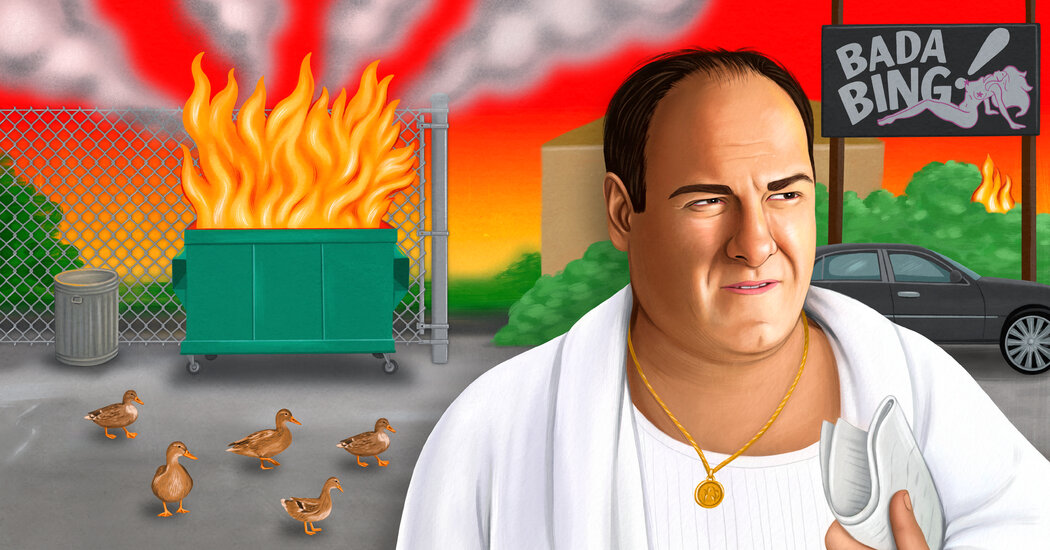
Looking at the film through Dainotto’s lens, “Many Saints” makes a timely update to the story of postwar American capitalism by focusing on who was left out of its embrace. Whatever nostalgic qualities the film has are undercut by the added perspective of Harold, a Black affiliate of the crew who is allowed to run, and violently enforce, the numbers racket in the Black neighborhoods. He beats and kills his own and kicks the profits up to a bunch of gangsters who treat him like scum — an unjust arrangement that can only last so long, and one not exactly unique to Harold. It is the eve of the riots that will ultimately disperse the working-class whites of the city, including the Soprano family, all over Essex County and beyond. And after Newark revolts, Harold follows suit: He starts his own numbers game.
Cinematic depictions of the Mafia tend, for obvious reason, to focus on the dramatic: the Lufthansa heist, the hit men, extortion schemes, broken thumbs, infiltration by the feds, wars between and within families. The reality of the mob is of course a lot more boring. As Chase put it to me: “They spend all day sitting around eating sandwiches and thinking of ways to outsmart the government or big business.” In New York, the Mafia’s real power came from its infiltration of a vast array of industries in the city: commercial waste-hauling, garment manufacturing, the docks, the Fulton Fish Market and construction. According to Selwyn Raab’s “Five Families,” the Lucchese family even had a racket in this very newspaper, through its control of the union that represented deliverymen, which it used to get no-show jobs and to steal and sell copies of The Times.
The Mafia was a parasite on a grubbier economy — one that was more tactile and localized than containerized and algorithmic. It was a grotesque mirror image of the American dream this economy enabled, a perverted form of upward mobility through hard work and enterprise. The key component enabling its industrial racketeering was control of unions, another choke point in an economy that had yet to become so totally manicured to suit the needs of corporations. Unions could be used as a two-way tollbooth. Employers could be pressured into giving regular kickbacks, in the form of cash or no-show jobs, through the threat of a strike — but they could also bribe mobbed-up officials to look the other way so they could hire nonunion labor.
Around the time “The Sopranos” premiered, the N.Y.U. Law professor James B. Jacobs wrote a paper, along with a student, arguing that the Mafia, though weakened by decades of prosecutions, could come roaring back. By 2019, though, he had published a new paper called “The Rise and Fall of Organized Crime in the United States,” declaring the Mafia all but finished. “The world in which the Cosa Nostra became powerful is largely gone,” he wrote. And he cites a litany of factors that aided its collapse, a mix of technological advances, deregulation and financialization — many of the same forces that have created the stratified economy of today.
Expanded access to credit had cut into what mobsters call the shylock business; there’s no need to go to a loan shark when the payday lender will offer you similarly competitive rates. Gambling was legalized in many states and flourishes on many reservations; nearly every state in the Union has a lottery, which decimated the numbers racket. Italian American neighborhoods have emptied out — as Jacobs writes, “radically diminishing the pool of tough teenagers with Cosa Nostra potential”; this is dramatized brilliantly in the final episode of the series, when a mobster from a New York family hurries through Little Italy on an important phone call and, when the call ends, looks around to see he’s wandered into an encroaching and vibrant Chinatown. And, Jacobs notes, union membership has been decimated. “In the mid-1950s, about 35 percent of U.S. workers belonged to a union,” he writes. “In recent years, only 6.5 percent of private-sector workers have been union members.”
Though hardly a friend to the worker, the Mafia rose to power in tandem with a postwar economy that was. It was an organization adept at finding and exploiting crevices in a world that still had crevices. And it has been surpassed, both onscreen and in reality, by a form of organized crime better suited to our era: the transnational drug cartels that mimic our immense global supply chain, corrupting the governments of the developing world while aiding the developed world’s slide into senescence.
The Mafia did famously plunder the Teamsters union pension fund to build Las Vegas (as dramatized in “Casino”) and then (probably) killed Jimmy Hoffa when he threatened their control of it (as dramatized in “The Irishman”). But they could never have accomplished what came next. The trucking industry was deregulated in 1980, which crippled the Teamsters’ bargaining power and membership (and, by making freight trucking so cheap, gave us big-box retail). In 1982, the Central States pension fund, which had been the mob’s piggy bank, was handed over to be managed by the big Wall Street banks. By the 2000s, the fund was facing shortfalls because of crippled union membership, and its Wall Street trustees made risky bets to cover the gap — bets that went south. In recent years, the fund was paying out $2 billion more than it was taking in annually, a situation that could have emptied it entirely by 2025, were it not bailed out by Congress this March. Say what you will about the Mafia’s stewardship of the fund, but at least they left us with a place to see Celine Dion and play craps.




